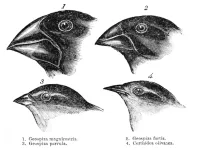What do infants see? What do they look at? The answers to these questions are very different for the youngest babies than they are for older infants, children and adults. Characterized by a few high-contrast edges in simple patterns, these early scenes also contain the very materials needed to build a strong foundation for human vision.
That is the finding of a new study, “An edge-simplicity bias in the visual input to young infants,” published on May 10 in Science Advances by IU researchers Erin Anderson, Rowan Candy, Jason Gold and Linda Smith.
“The starting assumption for everybody who thinks about the role of experience in visual development has always been that at the scale of everyday experience, visual input is pretty much the same for everyone,” explains principal investigator Linda Smith, a professor in the Department of Psychological and Brain Sciences. “Yet, this study says, no, visual input changes with development. It’s not the same for everybody. The daily life input for very young infants appears to be unique to that age.”
Prior studies in the laboratory and clinic had shown that young infants prefer to look at simple, high-contrast scenes of big black stripes and checkerboards. The current study is the first to ask to what extent these preferences make up their daily-life input. “To see what young babies see and look at,” says Anderson, a former postdoctoral researcher in Smith’s Cognitive Development Lab, she and her colleagues put head-cameras on infants to wear in the home during daily life activities.
“You can buy ‘baby flash cards’ for newborns that show these simple, high-contrast images,” she explains. “What the head-camera videos show, what this work shows, is that young infants find these types of images all around them in their daily life, just by looking at things like lights and ceiling corners.”
“What we found is a very special, early ‘diet’ for visual development,” adds Smith. “As with food, young infants do not start with rich, complex meals or pizza, but rather with simple, developmentally specific nourishment.”
Previous work has recognized the critical nature of this early period to the future development of human vision. For example, infants born with visual abnormalities such as cataracts or those in orphanages with limited visual experiences have been shown to have lifelong visual deficiencies. The current study offers some preliminary data for addressing these deficiencies. It also has important implications for the makings of AI visual systems, which likewise acquire stronger visual skills when training begins with the same simple, high-contrast visual content.
“The massive scale of daily-life input”
To identify the properties of visual input in infants at approximately three to 13 months old, the researchers placed head-mounted video cameras on 10 infants and 10 of their adult caregivers, collecting and analyzing 70 hours of visual documentation of at-home daily life. Clear differences emerge between the contents of the infants and adults’ images with a higher concentration of simple patterns and high-contrast edges within the views of infants than in those of adults.
Smith infers that the reason for these views is not only that infants will turn their heads to look at the features of the world they can see, but that parents or caregivers are likely to put them in places where they like to look at things. “You have to think why they are where they are. There is probably some natural knowledge implicit on the part of parents to leave infants where like to look at things. Mom’s not gonna bother you if you’re not fussing,” she observes.
Yet, is this small group of participants from Bloomington, Indiana representative of infants more broadly around the world? To answer this question Smith’s lab conducted the same experiment with a collaborator in a small, crowded fishing village in Chennai, India where electricity is minimal and much of daily life occurs outdoors. And while images from the head cameras of 6-month-olds and 12-month-olds looked very different from their Bloomington counterparts, the youngest infants share a common “diet” of high-contrast edges and simple patterns in both Chennai and Bloomington.
Bigger pictures, past and future
Smith and her collaborators have also shown that the same sequence of images improves the training of AI visual systems. In a follow-up to the current study, published in the 2023 Neural Information Processing Systems Conference Proceedings, they found that if you train an AI system by first feeding it images characteristic of early infancy, it has greater success learning to identify visual images than if you feed it images in a random developmental order or simply provide images typical of an adult’s daily life. The more precise developmental sequence produced the best results.
Their work opens up new avenues for evolutionary speculation. As Smith explains, “One of the things I always used to ask as a grad student – and maybe we’re getting a chance to answer it – is why do human babies have such slow motor development. They spend about three months just listening and looking and another six months with a little bit of posture and head control. Why are they so slow? Horses come out and run races.”
This research suggests that “over evolutionary time these slow, incremental and optimized biases work to build up a very smart visual and auditory system,” she says. “That’s a story that could be told.”
In the meantime, their work raises new questions on the visual content of early infancy and its role in the developing visual system, whether human or AI.
Other researchers include IU Bloomington professors Rowan Candy in the School of Optometry and Jason Gold in the Department of Psychological and Brain Sciences.
END




